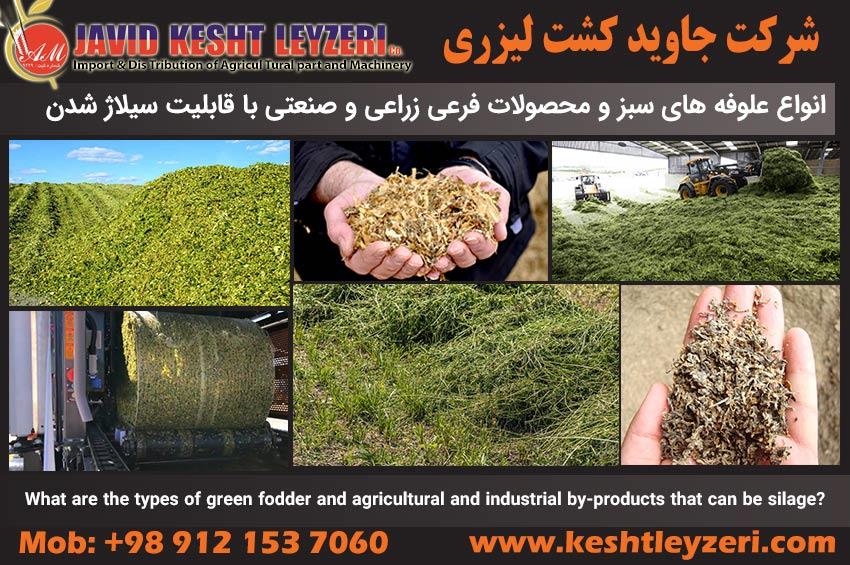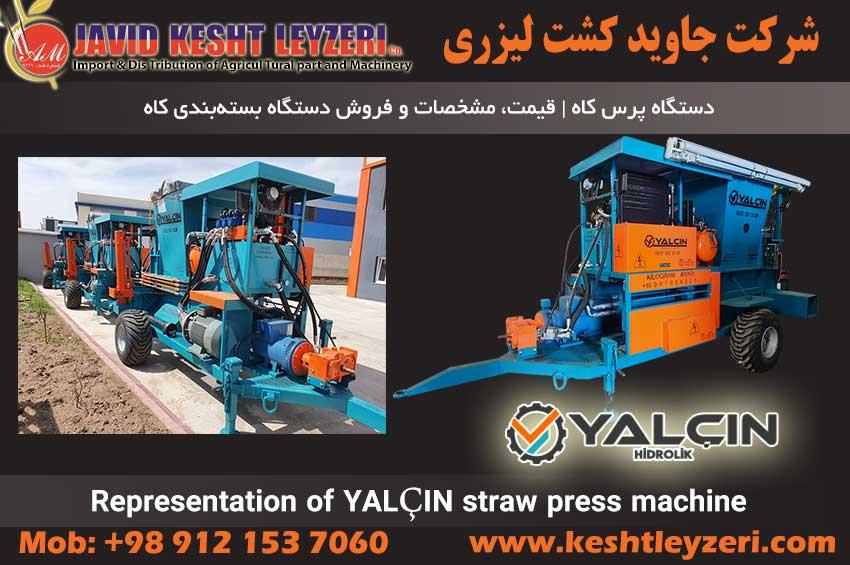
What are the types of green fodder and agricultural and industrial by-products that can be silage?
javid keshtleyzeri Co.ltd
Types of green fodder and agricultural and industrial by-products that can be ensiled are the following:
- Fodder corn silage (specifically: frozen fodder corn silage)
- Fodder clover silage
- Fodder hay silage
- Sugar beet pulp silage
- Sugarcane stalk silage
- Sugarcane bagasse silage
- Silage of vegetable and fruit residues from vegetable fields
- Municipal grass silage and the like
- Food industry waste silage
- Potato slice silage
- Olive meal silage
- Sorghum silage (corn silage)
- Pistachio By-product Hull silage
which are checked in order:
1- Fodder corn silage (specifically: frozen fodder corn silage)
Silage of fodder corn is not a new topic, but silage of frozen fodder in polyethylene bags is a significant issue that should be mentioned.
It often happens that with an early frost, silage fodder such as fodder corn is destroyed and cannot be harvested. This event may happen in different stages of growth. has been done, in that case the effects of frost on the plant will not be so serious. But if the entire aerial part of the plant is frosted while the cob seeding is not complete, then the production is seriously damaged. Frost occurs when the temperature The environment goes below zero for 5 to 6 hours or even for a few minutes the temperature of the environment is reduced to minus 2.5. The leaves have the most sensitivity to cold among the different parts of the corn body.
Despite the general belief about the destruction of frozen fodder corn, ensiling frozen fodder in polythene silage bags has brought favorable results. The reason for this is that compared to common silages, the oxygen contained in the silage material In the Begar silage system, it is quickly drained and does not allow aerobic fermentation and windage during ensiling.
If frozen fodder corn is in the milky seed stage or the early pulping stage, the moisture in the fodder will prevent it from being ensiled under favorable conditions. During this period, the cold was safe, in that case, by reducing the moisture content and reaching the desired level, this fodder can be quickly ensiled inside the bag. In such a situation, the chopped forage corn can be mixed with ground seeds, straw or chopped dry fodder and after ensuring the increase of the dry matter of this mixture, it can be ensiled. The general rule in this case is to increase 13.5 kilograms. dry matter (30 pounds of dry matter) per ton of mixture, which will result in a 1% reduction in silage forage moisture.
If the frozen fodder corn is in the dough stage or in the early stage of graining, the moisture level will still prevent a good silage. In that case, the above instruction regarding ensiling this fodder is also possible with less mixing of the mentioned ingredients. For frozen fodder corn that is in the middle or end of the granulation stage, ensiling inside the bag should be done immediately. Often, adding silage enhancers such as lactobacilli to frozen silage or silage with high humidity inside polyethylene bags will bring favorable results.
2- Forage clover silage and alfalfa
One of the most prominent tasks of Begar silage machines, in addition to ensiling fodder corn, is silage of the first and last furrow of field hay. One-year and multi-year clovers also obtain high-quality silage in Begar silage. Harvesting time and for all its folds is also economical.
The first Chinese alfalfa is usually low-quality alfalfa with very low nutritional value. The main reason for this can be seen in the nature of weeds, which grow at the same time as the initial growth of alfalfa, and because during their phenological stages, they grow faster than alfalfa itself. As a result, when harvesting the first layer of alfalfa, the weeds, which are mainly from the family of the cockscomb, are harvested in a woody state, which after a short period of time in the bales become worthless wood. But these alfalfas can be a High-quality alfalfa silage can be converted inside the nylons of the silage machine.
In some cattle ranches that grow alfalfa, they usually use fresh hay for feeding livestock. This is usually done in the first layer of hay. Due to the high moisture content of fresh alfalfa, when the same condition reaches livestock feeding, there is a risk of magnesium depletion. Blood and the occurrence of grass tetani, as well as rapid changes in rumen microbial flora, especially in high-breeding cows, will bring problems of metabolic complications.
In addition, dry alfalfa has a very low protein due to its loose leaves and significant shedding in the field and during transportation.
Hay silage is an exception to these cases, while its quality will be much better than fresh raw hay in order to preserve nutrients and increase digestibility. It is possible that the cowherd can harvest all the hay bales for silage and fill a percentage of the fodder. Allocate cattle volume to hay silage throughout the year.
Silage of alfalfa should be done by wilting method and by reducing its moisture after harvesting and before ensiling, which is an easy method and needs more explanation in its place. Alfalfa silage can be used for up to 15 months without significant loss in kept in a polythene bag. It goes without saying that the life of the silage depends on the thickness of the stretch film (plastic), the amount of adhesion, the ability to stretch while covering the mat, the resistance to tearing, the amount of anti-UV materials in it, the amount of penetration resistance It depends on oxygen and so on.
Several advantages have been experienced on the production of alfalfa silage in polyethylene bags, some of which are listed below:
- Long-term storage of green mass of alfalfa by maintaining its freshness
- Preventing loss of hay quality
- Better balance of ration, so that alfalfa silage can be used in the required amount throughout the year
Include in animal ration.
- Ease of transportation, storage and storage
- Economicity of alfalfa silage production
- Control the size of parts
- Increasing fiber digestibility
It is recommended to improve the work results in polyethylene bags by adding silage fermentation accelerators such as lactobacilli and the like to withered silage hay.
3-Sugar beet pulp silage
Another advantage of Begar silage is the storage of beet pomace for more than one year. The said device can keep sugar beet pomace that was produced at a point in time, which is a highly perishable by-product, fresh for at least 15 months. and can be stored easily. Sugar factory slag is supplied in two forms: dried and fluffier slag. Dry wastes are very expensive in terms of the high consumption of fossil fuel per kilogram of their production, and instead, they are much more durable than wet wastes.
Wet pulp contains 20 to 25 percent of dry matter (this ratio depends on the type of press used by each factory) and usually has 22 percent of dry matter. Due to the physical texture, the wet pulp has a low sugar content (0.8 to 1 percent). And the liquids contained in it cannot be ensiled under any circumstances. But inside polyethylene bags, it was miraculously preserved, and after a year or more passed, it was in a fresh form with the full characteristics of slag that was extracted from the factory within a day or two. it will be usable for livestock consumption. These characteristics make the farmers who use this device able to buy the manure at the time of production and store it for their annual consumption. Finishing corn is fodder and these two products can be put into the machine one after the other.
In recent years, the ensiling of pressed pulp has been extensively re-examined. In these studies, keeping fresh pulp in beggar silage for a long time showed a process with a very low percentage of waste and with the greatest cost savings. The results of these investigations led to the storage of this perishable material in silage bags in the amount of one million tons in the 93-94 crop year in Europe. They obtained more of the scum in the feeding of high production dairy cows with an average yield of 10,500 liters of milk per year.
The results obtained from the consumption of sugar beet pulp silage in the diet indicated the following:
- The same performance in milk production
- The same amount of fat and protein in milk
- No adverse effects and threats to the animal's health
- Less waste and corruption
Experimental feeding showed that it is possible to add up to 22 kg of fresh silage to the daily consumption of high yielding dairy cows in the diet. This amount is equivalent to 5 kg of dry matter per head per day. Regarding the consumption of fresh silage In the ration, the scientists were able to feed a much fresher food item with the least amount of dry matter. This was while the amount of milk production was not different from conventional feeds, in fact, the improvement in dry matter consumption was achieved by using beet pomace. Sugar was proven in their investigations. It is very important to pay attention to the costs in the results obtained. The cost is influential in the choice of any food. In this regard, the costs of consumption of cereal grains and fodder silage significantly decrease with the consumption of more waste. had found
As a result, silage with more pressed pomace has definitely included savings in animal feed, especially in high-yielding dairy cows, while it has not included any adverse metabolic and animal health effects.
4- Sugarcane stalk silage
Sugar cane tops contain significant nutrients, which unfortunately are lost during the harvesting of sugar cane, without any use for feeding livestock, and at the same time, environmental problems are caused by burning it and disrupting land preparation. It provides sugarcane for replanting or subsequent harvests. Ensiling it in rural communities in Africa and the Indian subcontinent with a method similar to ensiling in polyethylene bags has been popular for a long time, and to some extent, this product is wasted in small planting plots. Sugarcane has prevented it. In Kenya, Morilto Agricultural Development Institute of Kansas, USA has been able to evaluate the silage of sugarcane stalks, which is traditionally prepared in sacks and buried under the soil until the silage arrives, and qualitatively compare such silage with other silage fodder products. One of the noteworthy things in this study is the increase in the palatability of sugarcane shoots as well as the increase in its digestibility. Usually, to increase the lactic fermentation in this type of silage, adding a A carbohydrate source such as sugarcane molasses is recommended. Molasses can be added up to 5% of the weight of the branches.
5- Sugarcane bagasse silage
Sugarcane bagasse has a low quality and digestibility due to lignocellulosic materials. Previously, they used alkalis such as caustic soda (sodium hydroxide) or calcium hydroxide to break the sulfide bonds of cellulose and hemicellulose. But these methods, in addition to their high cost, disturb the balance of electrolytes in the body of consuming animals, and the resulting fertilizer also causes soil salinity. With the obsolescence of bagasse alkalization methods, high pressure hydrolysis methods and steam injection were replaced, but These methods also faced a lot of investment with a relatively low performance. It may be possible to consider silage of bagasse together with molasses (up to 10%) as a practical solution to produce a consumable product with palatable taste. Bagasse silage for fattening sheep and calves. It has good results and especially in drought years and lack of available fodder, it can be a breakthrough for livestock farmers.
6- Residue silage of vegetables and fruits from vegetable fields
One of the biggest problems in vegetable fields is the unsold vegetables remaining at the end of the day. Vegetables often have a high percentage of protein, and processing and turning them into silage can improve the quality of their consumption in livestock. Unfortunately, a huge part of these vegetables are all Discarded food, which is accumulated in garbage collection places, not only wastes this national capital, but also poses a serious threat to the health of the society and the environment. Recently, some fields have thought of drying these materials. are
Drying vegetables has two important drawbacks:
- During the drying process, a significant amount of its nutrients are changed and destroyed by the heat of the furnace, and it is called scorch.
- Expensive fossil fuel in drying these materials has made them an uneconomical product, and even in the expensive animal fodder market, this dried fodder obtained from the waste of vegetables does not have much demand.
Similar to silage of alfalfa, silage of vegetable residues from the fields of tarobar also has its own elegance. Such fodder cannot be ensiled in concrete bunker silos and the like, but their silage in polyethylene bags is of high quality. It has high quality and guarantees the storage period of this product in the bag for more than one year. The use of silo fermentation accelerators is also recommended for these products.
7- Municipal grass silage and the like
Grass residues from mowing lawns and flower bushes at the end of their flowering life in metropolitan municipalities have the ability to be ensiled in bagger silage, and doing this has become widely popular in Turkey.
8- Food industry waste silage
Such as pulp from fruit juice extraction, tomato paste, etc., pulp from tomato paste factories and juice production is considered as a rich source of fodder, the value of which is very high. Organic materials that decay quickly are very dangerous and their acidic nature causes the seepage resulting from the decay of these materials in the environment to destroy trees and plants in terms of soil pollution. It will pass the waste of vegetables and will have a unique quality and durability.
9- Potato slice silage
Raw potato and especially its green parts contain a large amount of solanine poison, which consumption without processing causes digestive disorders in animals. If it is consumed for a long time and in large quantities, it may cause cell wall rupture and intestinal swelling. It leads to the death of the animal. If potatoes are cooked in different ways, the mentioned poison is decomposed and destroyed by the heat of cooking. The same thing happens during the ensiling process of potato wedges. Due to its abundant starch, potato wedges are capable of anaerobic fermentation, and if molasses is added in the amount of 2 to 5%, it is a high-quality silage with energy-generating properties. It is very favorable for ruminants.
10- Olive meal silage
Olive meal has a low digestibility due to its lignocellulosic content. Instead, the remaining oil obtained from de-oiling, which is usually done without the use of chemical solvents, has made the amount of metabolizable energy to be considered. Ensiling it In bags of silage, it can help with molasses to improve its quality and prevent the oxidative swelling of the oil that occurs when exposed to air.
11- Sorghum silage (corn on the cob silage)
Sorghum or milo, which is also called ear corn in Farsi, is one of the valuable forages of the Gramine family, which can be harvested several times a year. Raw sorghum contains orosic acid, which is a poisonous substance. The ensiling process is decomposed and does not pose a risk to the consuming livestock.
12- Pistachio by-product hull silage
Every year, huge amounts of pistachio skin are produced in different areas of pistachio farming in the country, and because of its high tannin and high percentage of phenolic compounds, animals do not want to consume it raw.
In recent years, many investigations and experiments have been carried out by Iranian scientists in research and educational centers about ensiling fresh pistachio skins, which have achieved good results in order to reduce the amount of phenol and tannin in this product. Definitely, ensiling this product Seasonal and perishable in polythene bags can create a tremendous change in pistachio growing provinces, especially Kerman province.






